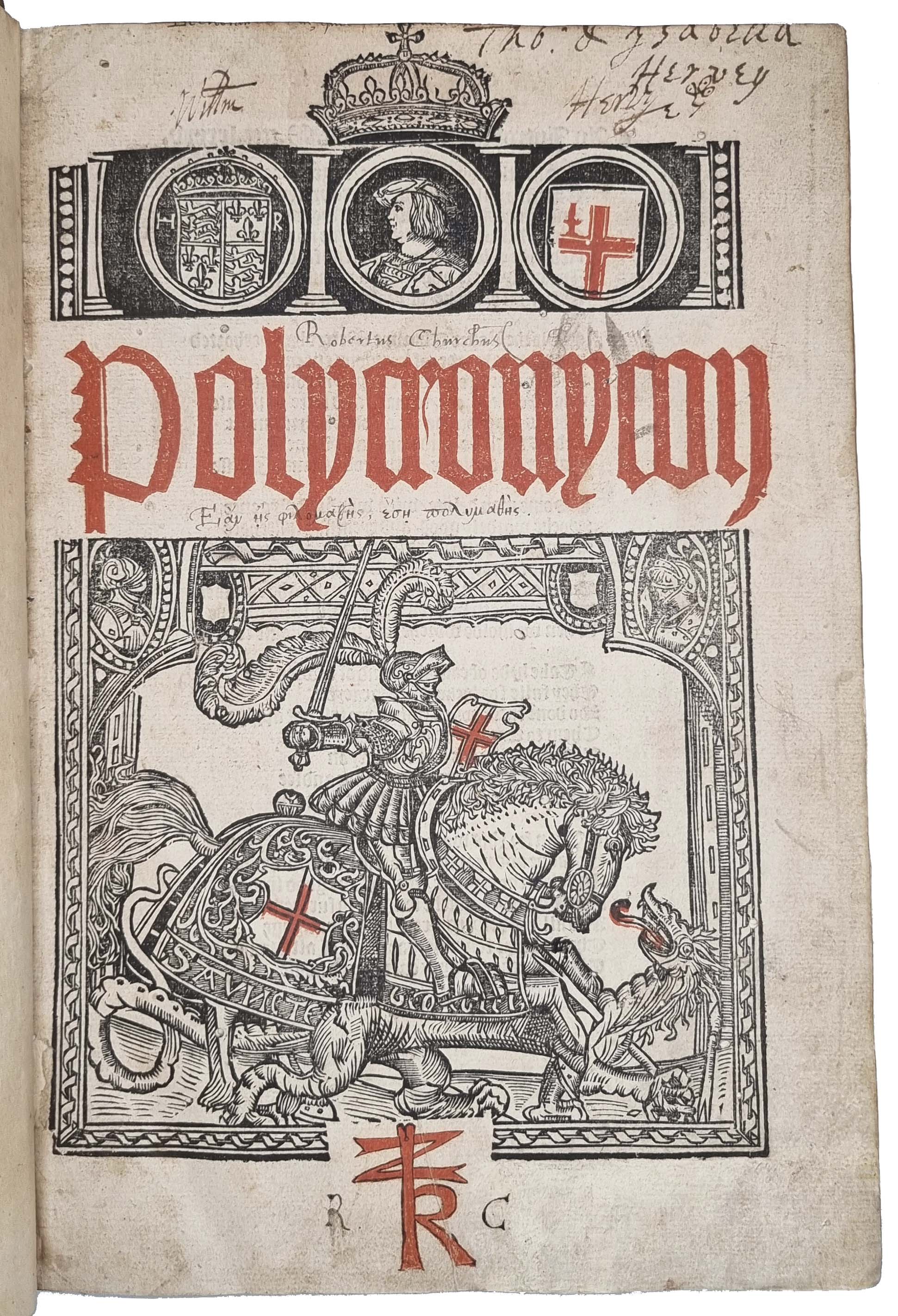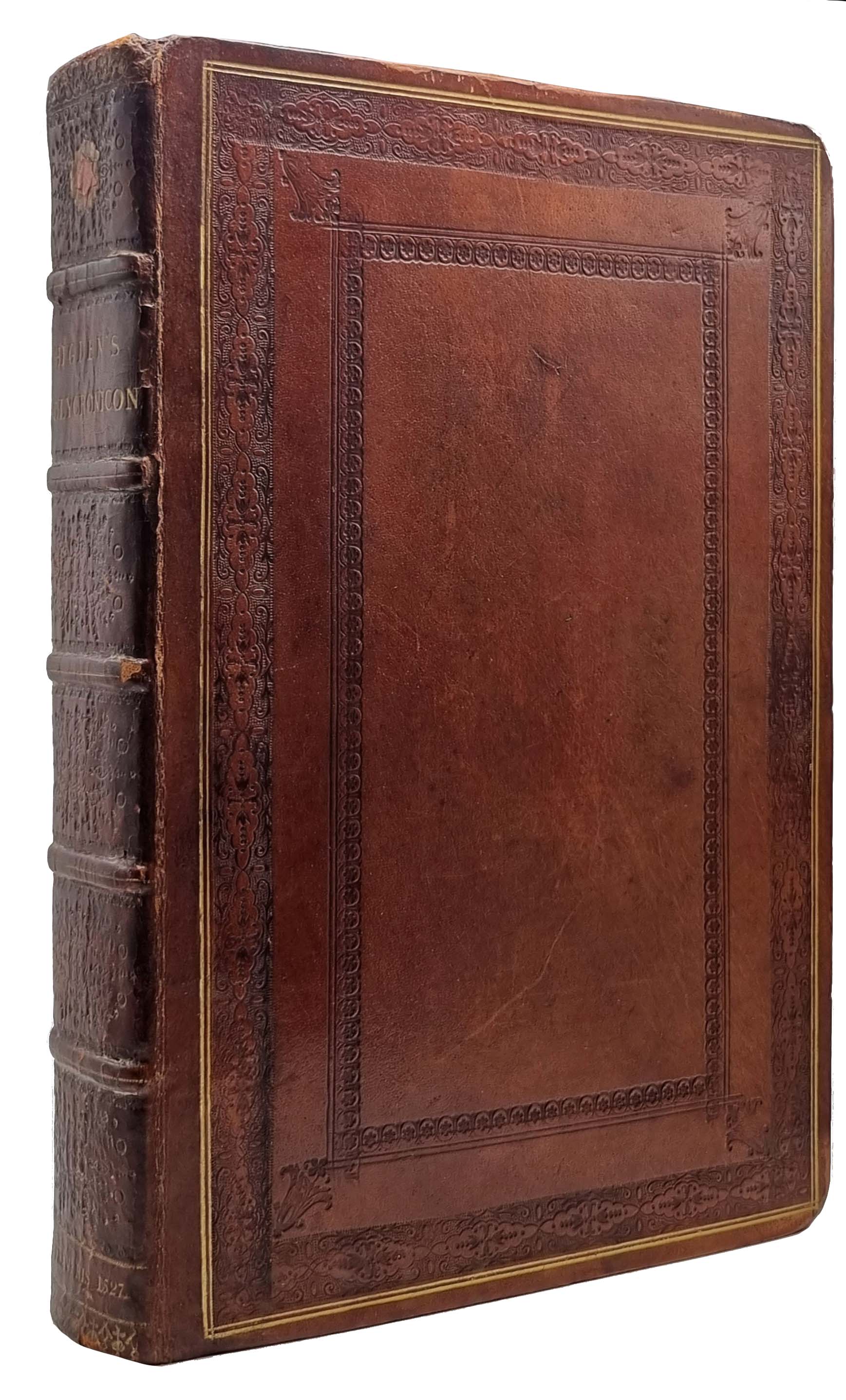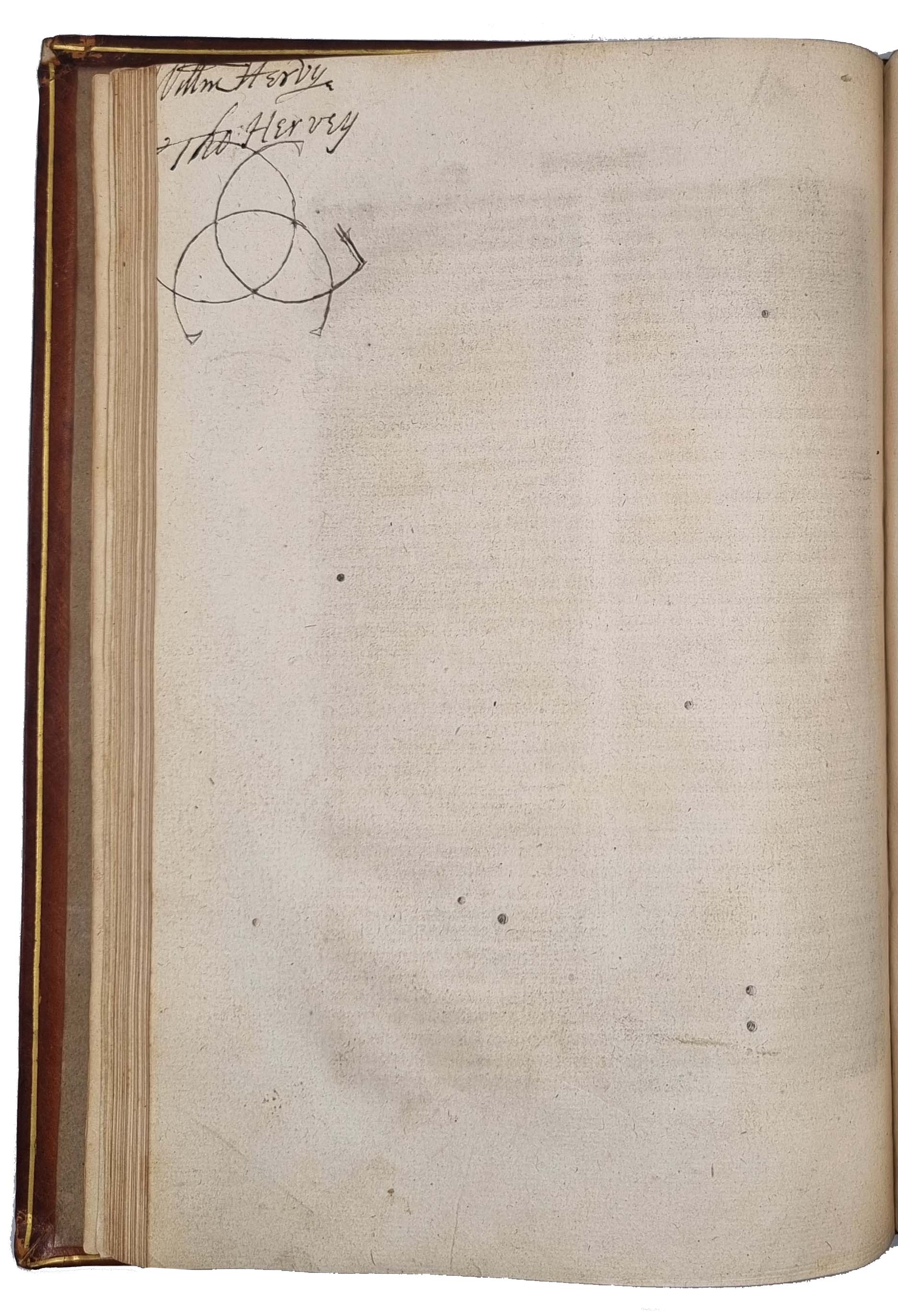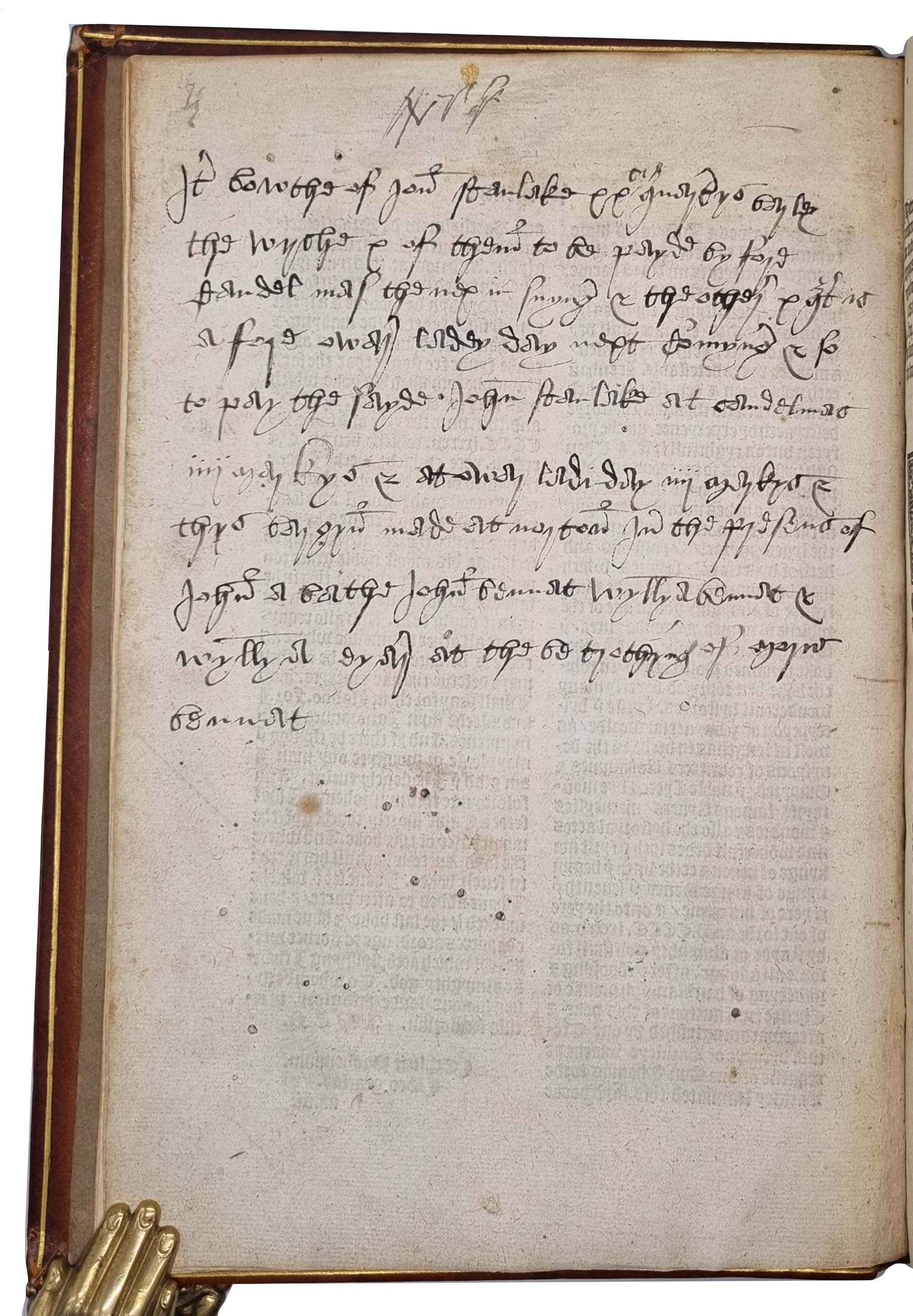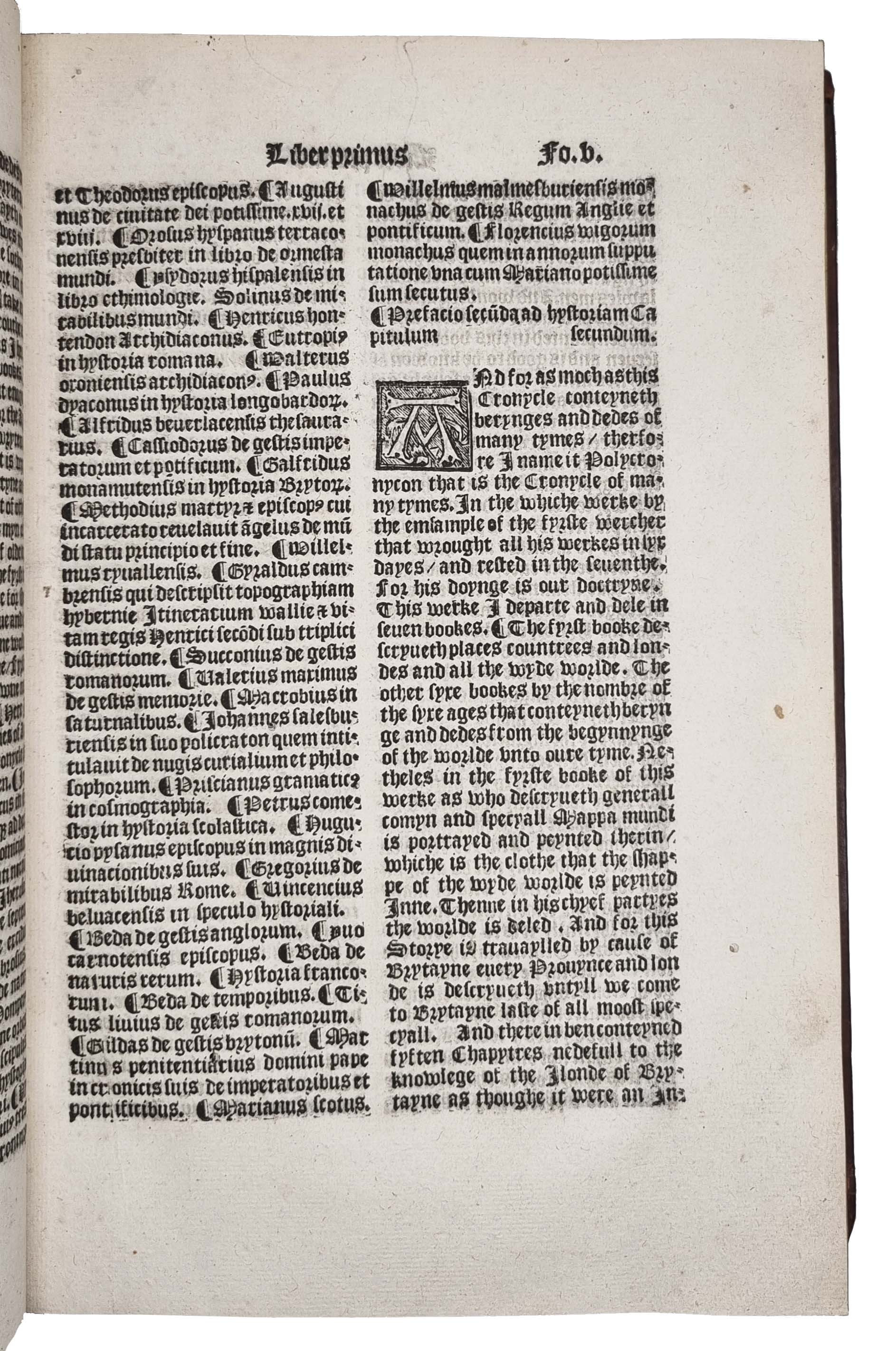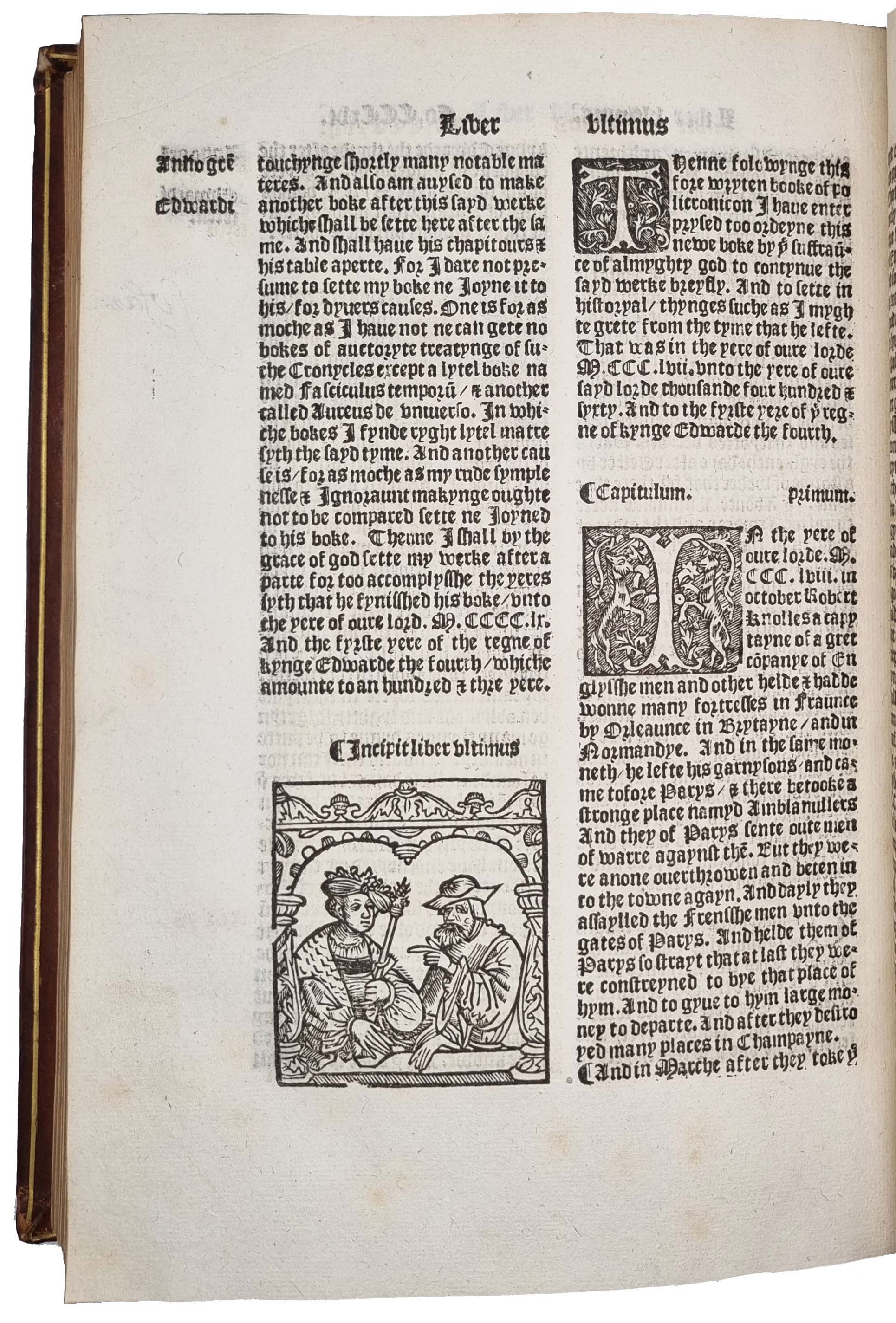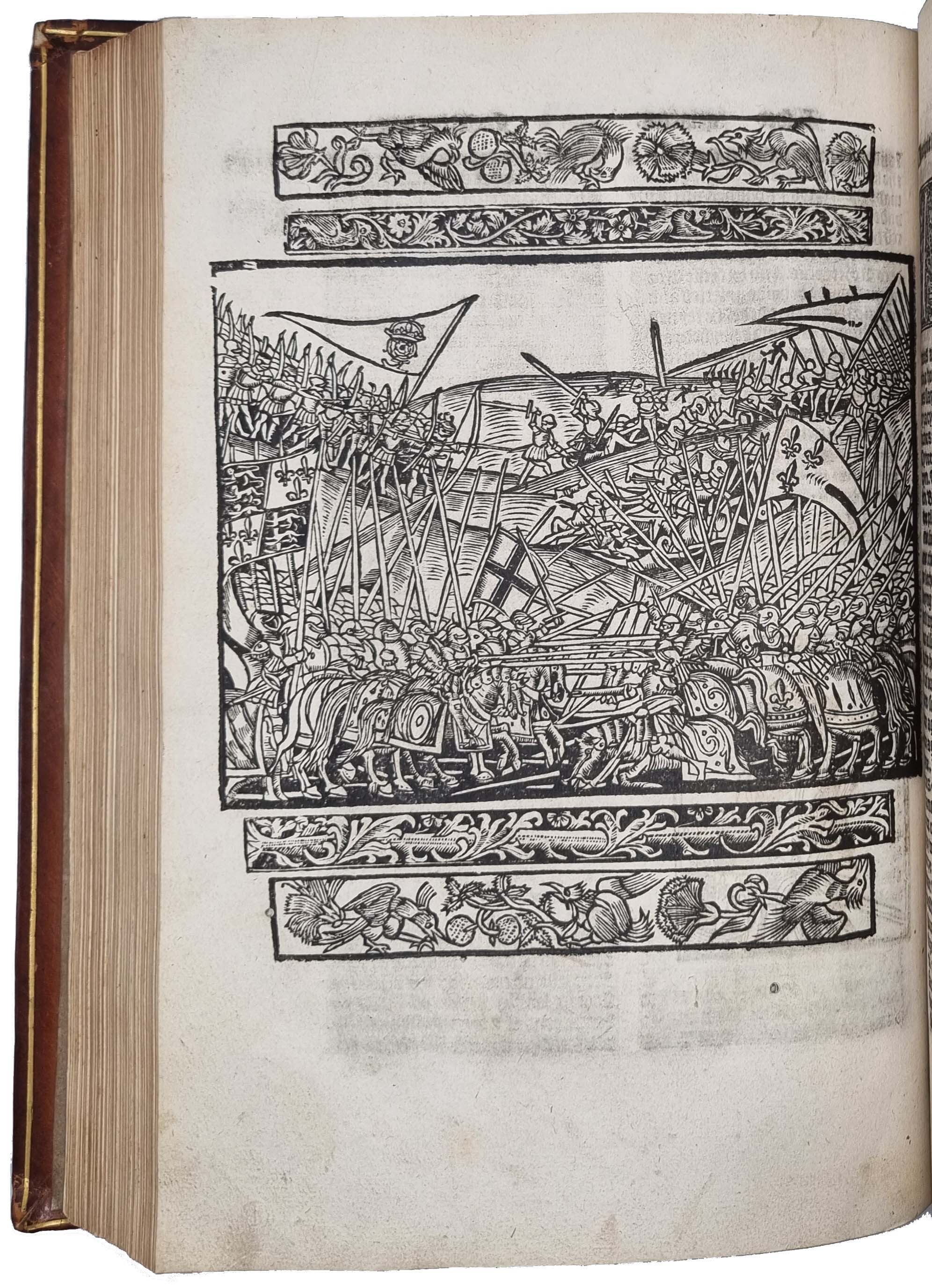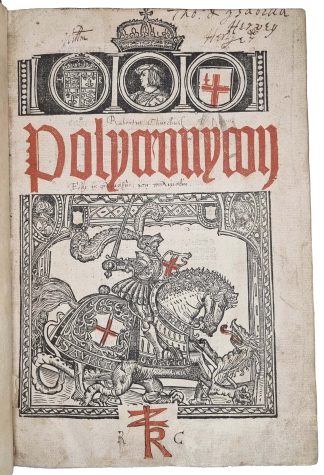HIGDEN, Ranulf
INTERESTING PROVENANCE
Polycronycon
Southwark, by my Peter Treueris at ye expences of Ioh Reynes, 1527£59,500.00
Folio. ff. [L] (the last blank), CCCxlvi [i.e. CCCxlvii], [i]. 2a , 2b-2h , a-y , z , A-S , T , U-X . Black letter, in double column, without catchwords. Woodcut title page, printed in red and black, with large woodcut of St. George slaying the dragon, incorporating Reynes’ monogram device (McKerrow 55), a woodcut crown at head, white on black woodcut below with profile portrait of Henry VIII, Royal Arms at left, Arms of the City of London at right, all repeated, joined together, on verso of last, (Hodnett, no. 2489), large woodcut of a battle with woodcut borders on verso of fol. 182, nine smaller cuts from six blocks in text, (Hodnett, no. 2490-2496), “the music cut, recto fol 101, when used in the 1495 edition of this book was the earliest music printing in England” Pforzheimer. Charming woodcut border for colophon (McKerrow & Ferguson. 12), woodcut white on black criblé initials, “Robertus Churchus” in a near contemporary hand on title (Robert Church), with his inscriptions in Greek below and his monogram either side of Reynes’ device, “Thomas and Isabella Hervey” and Willaim Hervey in early mss. at head of title, repeated on blank hh6 verso, long note in a contemporary hand on verso of aa3 (blank), occasional marginal note in a near contemporary hand, the word ‘Pope’ or ‘Papacy’ crossed out in places, modern bookplate on pastedown. Light age yellowing, a little offsetting or ink smudging in places (originally too heavily inked), title and verso of last fractionally dusty, small scattered single worm holes in places, occasional thumb mark or spot. A fine fresh copy, crisp and clean, in early C19th diced Russia, covers bordered with a double gilt rule, blind rules and rolls to a panel design, blind fleurons to corners, spine with gilt ruled raised bands, richly worked in blind in compartments, title gilt lettered, a.e.g. a little rubbed at upper joint and extremities.
A fine, fresh copy of the first illustrated edition of the Polycronicon, this “cornerstone of English prose” (Pforzheimer) translated by John Trevisa, and edited with a continuation by William Caxton. It is a reprint of Wynken de Worde’s 1495 edition with the addition of several woodcuts and omission of the date of Wynken de Worde’s edition at end. Written by the Benedictine monk Ranulf Higden (d. 1364) the Polychronicon “offered to the educated and learned audience of fourteenth-century England a clear and original picture of world history based upon medieval tradition, but with a new interest in antiquity, and with the early history of Britain related as part of the whole” DNB. Higden’s work, divided into 7 books and extending to the year 1348, was originally written in Latin. The English translation is by John de Trevisa, who continued the coverage to 1357. The 8th book was added by William Caxton, whose name appears on R6r, when in 1482 he printed Trevisa’s translation with extensive revisions
“Few of Caxton’s books have excited more interest and research than the ‘Polycronicon.’ It appears to have had its origin with Roger, Monk of St. Werberg, in Chester, who about the beginning of the 14th Century, made an extensive compilation in Latin from several of the old Chronicles and Works on Natural History then in existence. Ralph Higden, of the same monastery, who died before 1360, amplified this compilation, entitling the work, ‘Polychronicon,’ and this, judging from the numerous copies still extant, had a very extended popularity. In 1387, Trevisa, Chaplain to the Earl of Berkeley, translated the Latin of Higden into English prose. … Nearly a century later, Caxton revised the antiquated text of Trevisa, which, together with a continuation of the History to the year 1460, was finished on July 2nd, 1482, and printed soon after. Caxton entitled his continuation ‘Liber ultimus’ and it is most interesting as being the only original work of any magnitude from our Printer’s pen. .. Caxton tells us very little of the sources of his information. He mentions two little works, ‘fasciculus temporum’ and Aureus de universo’, from which, however he certainly obtained but little material for his ‘Liberultimus’ which treats almost entirely of English matters.” William Blades ‘The Life and Typography of William Caxton, England’s First Printer …, Volume 2.’
“It is clear that the English language production was very significant for Caxton. This was probably not because Caxton was more than usually devoted to his native language. There were good economic reasons for his choice. There was an international market for books in Latin, so if Caxton had printed Latin books, he would have been competing with some of the biggest publishers of his time. This would have been difficult to do successfully from England, on the margins of Europe. European printers also produced books in Latin specifically for English use. This demonstrates the strength of European book exports to England. Caxton left to others the production of texts to be used in universities or monasteries throughout Europe. Instead he concentrated on books in English, where there was little competition.When he printed Ranulph Higden’s Polycronicon, in John Trevisa’s translation of 1387, he updated the ‘rude and old englyssh, that is to wete certayn wordes, which in these dayes be neither vsyd ne understanden’ [rude and old English, that is, to wit, certain words which nowadays are neither used nor understood]. Caxton associated old usage with a lower social standing, calling it ‘plain and rude’ and implying that it was suitable for ‘rude’ men. The opposite is called ‘polished’, ‘ornate’, or ‘curious’. He was also acutely aware of regional variations. We saw him referring to his own Kentish background in the preface to his first translation, another theme which recurred at the end of his life.” BL
“Peter Treveris (alternatively known as Peter of Treves), a native of Germany, worked primarily in Southwark, London, closely pursuing his business partnership with Wynkyn de Worde between 1521 and 1533. Treveris published many books for de Worde… Several of his publications can be linked to commissions from patrons such as Robert Wyer and Bishop John Fisher.” Vassar College library. At his workshop in Southwark, he issued some 30-40 books, chief of which, was the present edition of the Polycronicon. Brunschwig’s “Noble Handiwork of Surgery,” the first printing of the influential “Grete Herball,” and John Skelton’s “Magnyfycence,”. “Treveris also shared with Wynkyn de Worde most of the printing of Richard Whittington’s scholastic works.” DNB
The work has most interesting provenance; Willian Hervey was a member of the landed gentry and a member of Parliament under James I. His son “[Thomas] Hervey is said to have ‘ventured his life … in the service of the King and country in the time of Charles I’, but he does not seem to have played a conspicuous part in the Civil War. During the Interregnum he occupied himself with courting his future wife, (Isabella) who was living in Bury St. Edmunds, but it was eight years before he was able to marry her. He was knighted either by Charles II in exile, or soon after the Restoration, and seems to have run the family estate after his father’s death in September 1660, … This responsibility, however, did not prevent Hervey from buying a seat on the navy board from Lord Berkeley of Stratton in 1664 for £3,000. His colleague Samuel Pepys found him ‘a very droll’ drinking companion, but disapproved of his working habits, particularly his absence during the plague. In November 1666 Pepys wrote that he “begins to crow mightily upon his late being at the payment of tickets; but a coxcomb he is and will never be better in the business of the navy.” The History of Parliament.
ESTC S119426. STC 13440. Pforzheimer 490. Grolier Langland to Wither 121. Steele Eng. Music printing no. 10. Ames 751 “splendid and rather uncommon impression” Lowndes 1067.In stock


